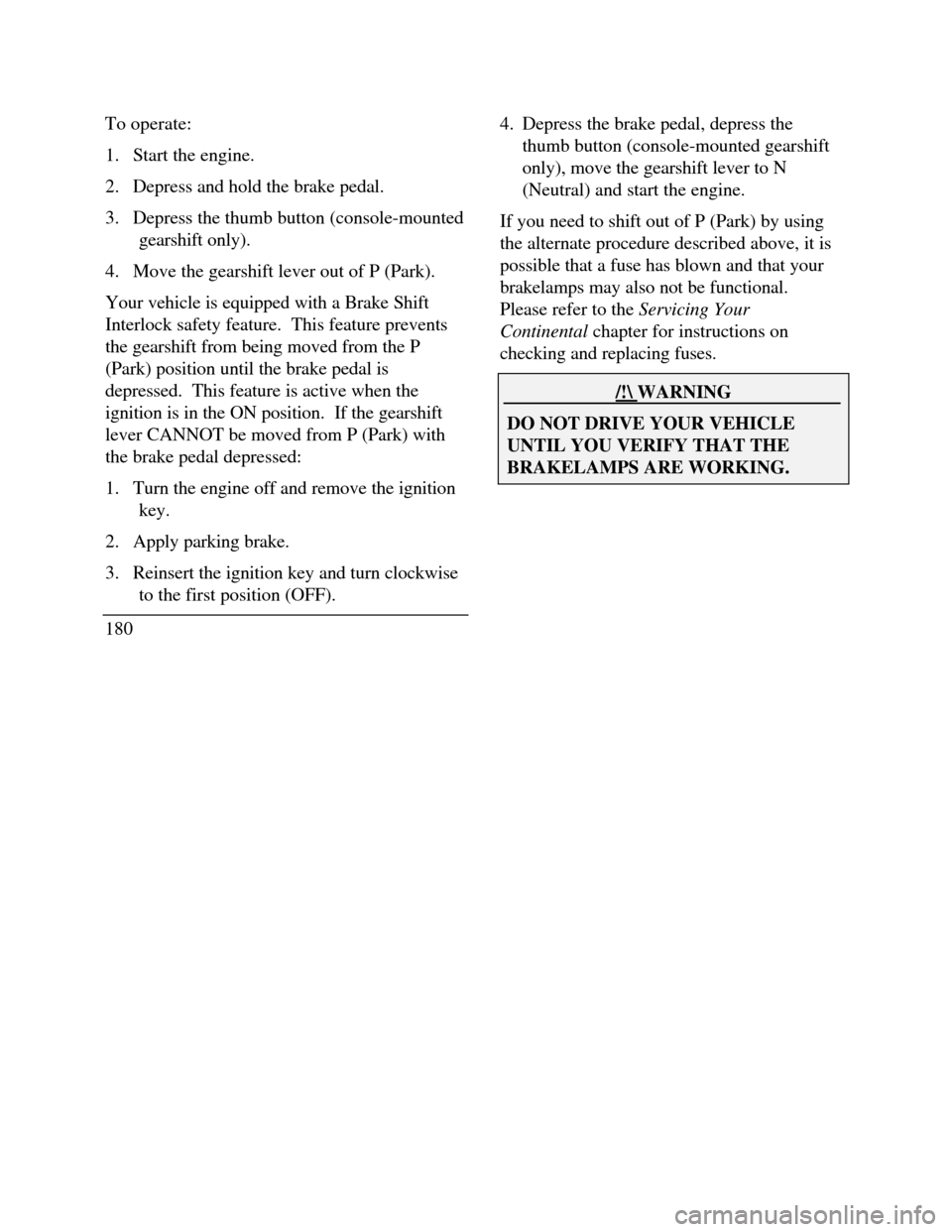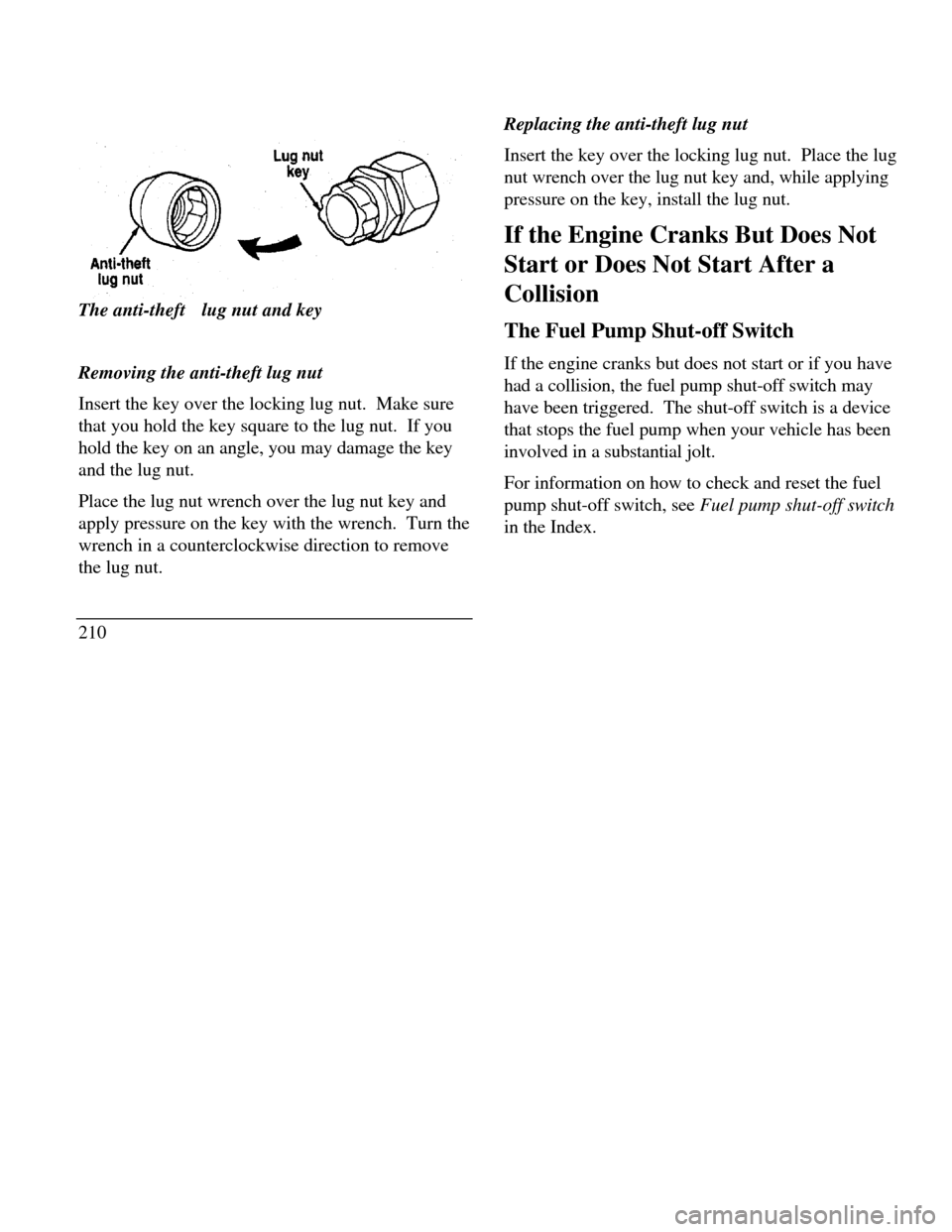check engine LINCOLN CONTINENTAL 1996 Customer Assistance Guide
[x] Cancel search | Manufacturer: LINCOLN, Model Year: 1996, Model line: CONTINENTAL, Model: LINCOLN CONTINENTAL 1996Pages: 320, PDF Size: 1.8 MB
Page 183 of 320

To operate:
1.Start the engine.
2.Depress and hold the brake pedal.
3.Depress the thumb button (console-mounted
gearshift only).
4.Move the gearshift lever out of P (Park).
Your vehicle is equipped with a Brake Shift
Interlock safety feature. This feature prevents
the gearshift from being moved from the P
(Park) position until the brake pedal is
depressed. This feature is active when the
ignition is in the ON position. If the gearshift
lever CANNOT be moved from P (Park) with
the brake pedal depressed:
1.Turn the engine off and remove the ignition
key.
2.Apply parking brake.
3.Reinsert the ignition key and turn clockwise
to the first position (OFF).
1804.Depress the brake pedal, depress the
thumb button (console-mounted gearshift
only), move the gearshift lever to N
(Neutral) and start the engine.
If you need to shift out of P (Park) by using
the alternate procedure described above, it is
possible that a fuse has blown and that your
brakelamps may also not be functional.
Please refer to the Servicing Your
Continental chapter for instructions on
checking and replacing fuses./! WARNINGDO NOT DRIVE YOUR VEHICLEUNTIL YOU VERIFY THAT THEBRAKELAMPS ARE WORKING.
Page 188 of 320

In general, this system improves your vehicle's
stability and acceleration performance when road
conditions warrant. Traction ControlÔ is fully
effective at all vehicle speeds.
If the Traction ControlÔ system is cycled
excessively, the brake portion of the system will shut
down to prevent the front brakes from overheating.
A limited Traction ControlÔ function using engine
torque will still control wheels from spinning. A
cooling down period is required to prevent damage
to the brakes. This time period varies and depends
on brake usage during the cooling down period.
Anti-Lock braking is not affected and will function
normally during the cool down period.
After the cool down period, the full Traction
ControlÔ' function is restored.Steering Your Vehicle
Your vehicle comes with power steering.
Power steering uses energy from the engine to
help steer your vehicle.
If the amount of effort needed to steer your
vehicle changes, check your steering effort
selection in the Message Center. If this is not
the problem, have the power steering system
checked. If the power steering system breaks
down (or if the engine is turned off), you can
steer the vehicle manually but it takes more
effort.
The steering system in your vehicle is speed
sensitive. This means that the steering effort is
light for parking and heavier for highway
driving. However, if you have to swerve
around an object or another vehicle, your
steering will have full power assist.
185
Page 190 of 320

Brakes
Applying the Brakes
Your vehicle has anti-lock disc brakes on all four
wheels. They adjust automatically as the brake pads
wear down.
When you press down hard on the brake pedal, the
wheels will not lock and slide. The Anti-lock Brake
System (ABS) automatically starts releasing and
reapplying the front brakes independently and the
rear brakes together whenever your wheels start to
lock. When this happens, you will feel the brake
pedal pulsate. This is an indication that the ABS
system is working correctly and is normal.
Each time you turn the ignition key to the ON
position, the anti-lock brake system will function
through one test cycle. When this happens, the ANTI-
LOCK light will come on for up to five seconds and a
clunk may be felt in the pedal. If the light stays on
longer than five seconds, shut off theengine and restart. If it remains on, it means the
anti-lock brake system is disabled and should be
serviced immediately to restore the benefits of
the anti-lock feature. Normal braking is not
affected unless the brake warning light is also lit.
The And-lock Brake System has self-check
capabilities. As described above, the system
turns on the ANTI-LOCK light each time you
start your engine. After the engine is started
and the ANTI-LOCK light turns off, the system
performs another test the first time the vehicle
reaches 14 m.p.h. (22 km/h). The system turns
on the ABS pump motor for approximately 1/2
second. At this time, a mechanical noise may
be heard. This is a normal part of the self-
check feature. If a malfunction is found during
this check the ANTI-LOCK light will come on.
Do not drive with your foot resting on the
brake pedal; you will wear out the linings and
increase your vehicle's stopping distance.
Brake rotor damage may also eventually occur.
187
Page 193 of 320

You have an automatic release for the parking brake.
The parking brake should automatically unlock when
you move the gearshift to any forward gear while the
engine is running. However, the automatic release
does not work when the gearshift is in reverse,
neutral or park.
To manually release the parking brake, pull the
BRAKE RELEASE handle located on the lower left
comer of the instrument panel. The Brake Warning
Light will illuminate if the parking brake is not fully
released when the engine is running.
The parking brake is not designed to stop a moving
vehicle, but you can use the parking brake to stop
your vehicle in an emergency if the normal brakes
fail. However, since the parking brake applies only
the rear brakes, the stopping distance will increase
greatly and the handling of your vehicle will be
adversely affected.
190Always check the Brake Warning light each
time you start your engine. Driving with the
parking brake on will cause the brakes to wear
out quickly and will reduce the fuel economy.
Driving Under Special Conditions
Tips for Safe Driving
As with any new vehicle, yours may drive and
handle differently from your previous vehicle.
Use care until you become accustomed to its
various features and driving characteristics.
Operate your vehicle within reasonable limits.
Sudden acceleration, deceleration, turning, or
combinations of these maneuvers can cause a
vehicle to behave differently than anticipated.
Page 199 of 320

Towing ClassLight-dutyMaximum gross trailer
weight1,000/2,000 lbs. (454/907
kg)*Maximum tongue load100/200 lbs. (45/91 kg)Engine4.OLHitch designLoad carrying typeTraffer-tow package
optionNot requiredVehicle speed should not exceed 45 mph (72 km/h) when
towing on grades. Limit maximum gross trailer weight to
1,000 lbs. (454 kg) and maximum tongue load to 100 lbs. (45
kg): (1) when you are towing a trailer on steep hills or on
moderate hills for a long distance (five miles (8 kms) or more)
(2) on very hot days (when the temperature is 1OO°F (38°C)
or more).
You should also limit your trailer's load when you
tow in high altitudes.
196Preparing to Tow
For your safety and for the good of your
vehicle, use the right equipment for the type of
trailer you tow. Also, make sure that all
towing equipment is properly attached to your
vehicle. If you are not certain that you are
using the right equipment in the proper manner,
see your Ford or Lincoln-Mercury dealer.
Do not use hitches that clamp onto your
vehicle's bumper. The bumper is not designed
to bear the load.
Always check the pressure in all your vehicle's
tires when preparing to tow (see inflation
recommendation on the tire label).
Connecting the safety chains
Always attach the trailer's safety chains to your
vehicle. They help protect your trailer if the
hitch breaks.
Page 203 of 320

/! WARNINGBatteries contain sulfuric acid which bumsskin, eyes, and clothing.If the acid touches someone's skin, eyes, or clothing,
immediately flush the area with water for at least 15
minutes. If someone swallows the acid, have him or
her drink lots of milk or water first, then Milk of
Magnesia, a beaten egg, or vegetable oil. Call a
doctor immediately.
To avoid damaging your vehicle or your battery, and
to avoid injury to yourself, follow these directions
for preparing your vehicle to jump-start and
connecting the jumper cables in the order they are
given. If in doubt, call for road service.
200Preparing Your Vehicle
1 .Your vehicle has a 12-volt starting system, so
you need to use a 12-volt jumper system. You
will damage your starting motor, ignition system,
and other electrical parts if you connect them to a
24-volt power supply (either two 12-volt
batteries in series,or a 24-volt generator set).
2.Do not disconnect the battery of the disabled
vehicle. You could damage the vehicle's
electrical system.
3.Park the booster vehicle close to the hood of the
disabled vehicle. Make sure the vehicles do not
touch each other. Set the parking brake on both
vehicles and stay clear of the engine cooling fan
and other moving parts.
4.Check all battery terminals and remove any
excessive corrosion before you attach the jumper
cables.
Page 213 of 320

Lug nut key Anti-theft lug nutThe anti-theftft lug nut and key
Removing the anti-theft lug nut
Insert the key over the locking lug nut. Make sure
that you hold the key square to the lug nut. If you
hold the key on an angle, you may damage the key
and the lug nut.
Place the lug nut wrench over the lug nut key and
apply pressure on the key with the wrench. Turn the
wrench in a counterclockwise direction to remove
the lug nut.
210Replacing the anti-theft lug nut
Insert the key over the locking lug nut. Place the lug
nut wrench over the lug nut key and, while applying
pressure on the key, install the lug nut.
If the Engine Cranks But Does Not
Start or Does Not Start After a
Collision
The Fuel Pump Shut-off Switch
If the engine cranks but does not start or if you have
had a collision, the fuel pump shut-off switch may
have been triggered. The shut-off switch is a device
that stops the fuel pump when your vehicle has been
involved in a substantial jolt.
For information on how to check and reset the fuel
pump shut-off switch, see Fuel pump shut-off switch
in the Index.
Page 233 of 320

Servicing Your ContinentalService Made Easy
Ford has two goals for servicing your vehicle.
1. When we can, we design parts that do not
need to be serviced.
2. We want to make servicing your vehicle as
easy as possible. To help you: We highlight do-it-yourself items in yellow in
the engine compartment so that you can find them
easily. When possible, we design - such as the
headlamp bulbs-- that can be replaced without
tools. We give you a Maintenance Schedule that
makes tracking routine service for your vehicle
easy. The maintenance schedule is located in
the Maintenance Schedule and Record booklet.This chapter tells you about the basic parts that you
need to check and service regularly.
If your vehicle needs professional servicing, your
dealership can provide the parts and service required.
Check your Warranty Information Booklet to find out
which parts and services are covered. Also see the
Customer Assistance chapter of this Owner Guide.
Ford Motor Company recommends that the Owner
Maintenance Checks listed in the Maintenance
Schedule and Record booklet be performed for the
proper operation of your vehicle. In addition to the
conditions listed in the Owner Maintenance Checklist,
be alert for any unusual noise, vibration, or other
indication that your vehicle may need service. If you
do notice something unusual, see that your vehicle is
serviced promptly.
231
Page 244 of 320

Avoid breathing vapors while refueling. If fuel is splashed on the skin, wash with soap
and water. If fuel is splashed in the eyes, remove contact
lenses (if worn), flush with water for 15 minutes,
and seek medical attention.
Gasoline and gasoline blends may contain small
amounts of carcinogens, such as benzene. Long-
term exposure to unleaded gasoline vapors has
caused cancer in laboratory animals.
if you are taking the medication "Antabuse" or
other forms of disulfiram for the treatment of
alcoholism, vapor or skin contact with a gasoline-
methanol blend, may cause the same kind of adverse
reaction as drinking an alcoholic beverage. In
sensitive individuals, serious personal injury or
sickness could result. Consult a physician promptly
if you experience an adverse reaction.
242Running Out of Fuel
NOTE: Avoid running out of fuel because this
situation may have an adverse effect on modern
powertrain components.
You may need to crank the engine several times
before the fuel system starts to pump fuel from the
tank to the engine.
If the engine does not start, check the fuel pump
shut-off switch and reset as required. See Fuel pump
shut-off switch in the Index./!\ WARNINGNever pour fuel in the throttle body orattempt to start the engine with the aircleaner removed. Doing so could result infire and personal injury.
Page 246 of 320

Using speed control in hilly terrain Extended use of the A/C, defroster, rear window
defroster and other accessories Underinflated tires Heavy loads Aftermarket add-ons such as bike, ski or luggage
racks, bug deflectors, etc.
Self-Service Pointers
If you choose to do your own fueling, you should
also perform a few simple maintenance routines.
This extra effort will save you additional money and
contribute to the driving efficiency of your vehicle.
The following procedures require only a tire gauge,
a rag, an oil can spout and windshield washer fluid.Check the engine oil at every refueling stopClean the windshield, outside mirrors and
headlights
244 Check windshield washer fluid Check tires for excessive wear or worn edges Check the tire pressure at least monthly
Engine Oil Recommendations
We recommend using Motorcraft oil or an equivalent
oil meeting Ford Specification ESE-M2C153-E and
displaying the American Petroleum Institute
CERTIFICATION MARK on the front of the
container.